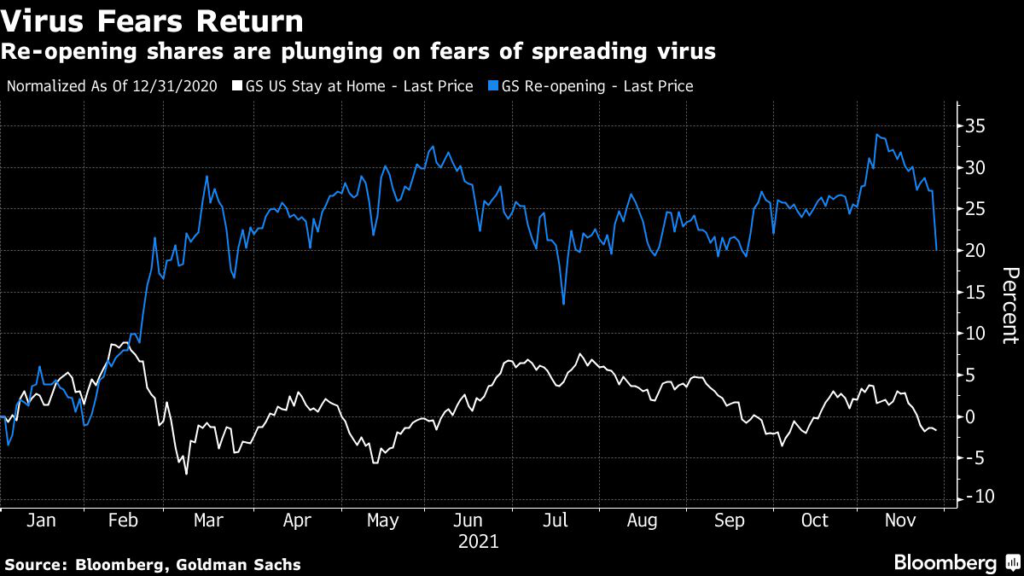(Bloomberg) — Wall Street has had plenty to be grateful for this year: Sixty-six records for the S&P 500 Index. Stock funds luring more cash in 2021 than in the previous 19 years combined. One of the fastest profit recoveries in history.
Now American traders barely finished with Thanksgiving just got a reality check as global markets plunge on the discovery of a new coronavirus strain in southern Africa.
The S&P 500 posted its biggest slide Friday since February on news that scientists and policy makers are rushing to determine how infectious the new variant may be.
Treasuries headed for their sharpest rally since March 2020. Oil and industrial metals plunged. Speculative assets like Bitcoin extended its decline to more than 20% versus the all-time high notched earlier this month.
A stock bull run for the history books in the grip of a once-in-a-century virus always demanded gumption from the investing class. Now the tenacity of bulls is set for a fresh test as the Federal Reserve-versus-inflation narrative takes a backseat to fears the world is about to enter a new chapter of the pandemic.
“If we go into lockdowns now we may end up with even higher inflation because of supply chain pressures,” said Barry Norris, founder of Argonaut Capital Partners. “Central banks aren’t going to be able to come to the rescue this time.”
The equity leaderboard at the end of the holiday-shortened week echoed the dark days of Covid trading: Stay-at-home shares like Zoom Video Communications Inc. and Peloton Interactive Inc. jumped, while airline shares dropped back into negative territory for the year.
In one view, the market slide shows how little virus risk premium is built into global equities. Valuations are above their decade average. A basket of U.S. reopening stocks is 20% higher this year.
But much remains unknown about the new strain, including the efficacy of current vaccines, its rate of transmission and the likely policy response. Compared to early 2020, governments and hospitals are much better equipped to deal with the novel virus and more antiviral treatments are available.
Before news of the new variant spread, Wall Street was busy publishing outlooks for 2022 that projected more of the same: Solid risk appetite in markets with the U.S. recovery trudging along thanks to the vaccine buoying stocks anew.
But the investing playbook based on inflation, monetary tightening and earnings suddenly looks less certain.
“Consensus forecasts for next year are very much on the bullish side,” Ella Hoxha, senior investment manager at Pictet Asset Management, told Bloomberg TV. “Perhaps you have to take a probability event with a more severe pandemic outcome. That’s what the markets are doing — buying some downside protection.”
The bull case is that, thanks to the sharp profit recovery, the MSCI World’s price relative to its 12-month forward earnings has actually dropped this year. And low bond yields continue to make the earnings yield of stock benchmarks look even more alluring.
The bearish argument is that an expected earnings multiple of 19 for the global index compares with 17 at the end of 2019 and a decade average of nearly 16. So even by post-crisis standards, valuations look lofty.
Which side prevails may hinge on whether central banks will delay cutting stimulus if the virus spreads anew, threatening economic activity. Any enduring shift in monetary calculations has the capacity to whipsaw global markets.
In money-market bets, traders delayed the timing of the first U.S. rate hike to September from June and slashed wagers that the euro zone would see a higher deposit rate by end-2022.
“If this is going to take the world backwards from a Covid perspective, then it’s likely that inflation will abate and monetary policy will stay looser for a long time, which is likely to be a positive for markets in the medium term,” said Dan Boardman-Weston, chief investment officer at BRI Wealth Management.
Popular investing styles are therefore once again at the mercy of unpredictable virus headlines — and in turn the interest-rate response. Among strategies deployed by quant investors, a trade that buys value stocks and dumps pricey ones dropped on Friday. The flight to safety also fueled a jump in trades tied to profitable and low-volatility shares, while hurting a bet on small-cap outperformance.
“The normalization trade will get delayed, which is reflected in stock prices this morning,” Max Anderl, senior portfolio manager at UBS Asset Management, wrote in an email. “Until more is known, the risk trade that relied on higher bond yields will most likely see some profit taking.”
More stories like this are available on bloomberg.com
©2021 Bloomberg L.P.











